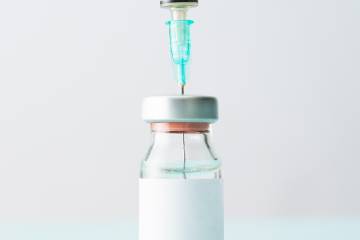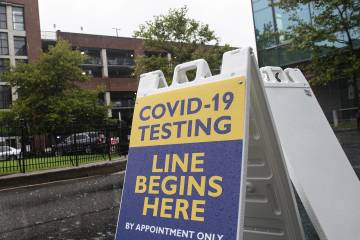Three pharmaceutical companies have developed COVID-19 vaccines that offer some hope for preventing the spread of a disease that has infected more than 58 million people and claimed more than 1.3 million lives globally. But as Daniel Salmon, a professor at the Johns Hopkins Bloomberg School of Public Health and director of the Institute for Vaccine Safety cautions, a vaccine doesn't save lives. Vaccinations do. And there's still so much work to do to turn a vaccine into an effective vaccination strategy.
"Keep in mind before COVID started at the end of 2019, we were seeing reoccurring outbreaks of measles—in fact, we almost lost our measles elimination status that year," Salmon said during the Nov.20 COVID-19 Symposium at Hopkins, Navigating the Pandemic When Effective Vaccines Are in the Policy Toolbox, a virtual event hosted by the Hopkins Business of Health Initiative that drew roughly 3,000 viewers.
Salmon noted that in 2019 the WHO named vaccine hesitancy one of 10 threats to global health. Vaccine hesitancy is partly rooted in a lack of trust in government and public health, and Salmon brought these facts up because "I think it speaks to how pervasive these issues were in our society before COVID, where roughly one out of three parents were hesitant about vaccines, and then looking at how COVID was responded to in this country, with major reductions in the credibility of our public health agency."
Salmon's words emphasized that, despite the promise offered by the rigorously swift development of the Pfizer, Moderna, and AstraZeneca Oxford vaccines, they're only a first step in the ongoing efforts to control the spread of the disease and save lives.
The symposium was kicked off with a keynote address by Anthony Fauci, director of the National institute of Allergy and Infectious Diseases. His talk, titled "COVID-19: Public Health and Scientific Challenges," provided an information-rich overview of the novel coronavirus, its emergence in China and spread throughout the U.S., what public health measures were somewhat effective but not effective enough to flatten the curve of infections in the U.S., what current treatments are available, and how the many vaccine development projects are progressing.
While Fauci commented on the speed with which both Pfizer and Moderna were able to create their messenger-RNA vaccines, he also noted the challenges ahead.
"We know what the efficacy of the vaccines are, but its effectiveness will depend on how many people take the vaccine," Fauci said, acknowledging that "we're left with a significant problem in that there's a great degree of skepticism about vaccines [and] science, in general, that we have to overcome. If you look at the slide recently published in Science, up to 50% of the people [in the U.S.] feel they're not quite sure or they don't want to take the vaccine. So we have our job cut out for us to convince people that the process by which this vaccine was developed was both transparent and scientifically sound and independent."
The WHO estimates that between 65-70% of a population needs to be vaccinated in order to prevent outbreaks, and no vaccine can prevent anybody from becoming ill if half the population isn't on board.
Fauci's talk was followed by a pair of panel discussions about possible ways to overcome those challenges. The first, titled "Barriers and strategies to achieving optimal COVID-19 vaccination rates," included Brookings Institution fellow Robert Litan suggesting the U.S. government pay people to get vaccinated. Johns Hopkins Bloomberg Distinguished Professor and health care policy expert Daniel Polsky pointed out that free vaccines don't always mean that a member of the public won't be charged. Vaccination providers can charge a fee for administering a shot, which can be reimbursed by patients' insurance provided but may also be passed along to those without insurance.
University of Pennsylvania School of Nursing behavioral scientist Alison Buttenheim talked about using social influence to increase participation—something similar to the "I Voted" sticker, but for vaccinations, or encouraging mayors, CEOs, or celebrities to vaccinate publicly so that people see leaders doing it as well. Of course, "what works best for a Black church in Philadelphia is not going to work for a small town in the upper peninsula of Michigan or a chapter of the Navajo nation in the Southwest," said Buttenheim , who added that any behavioral interventions have to be tested during rollout to continue increasing participation. "We need kind of rapid cycle testing to learn quickly what works and for whom, because we have a narrow window of time to get this right."
Salmon agreed. "We need to tailor messaging," about the disease and vaccine, he said, picking up on Buttenheim's remarks about the need to reach so many different populations. "We need to know what the population thinks about the disease and the vaccine. We need to know how it varies by population. We need to know what credible sources are among those subpopulations. And then we need to know how to message within those individual areas."
The second panel included presentations by a variety of mathematical modelers and biostaticians who synthesize new data about the pandemic to help policymakers and frontline health care workers make decisions. Nilanjan Chatterjee, a Bloomberg Distinguished Professor of Biostatistics and Genetic Epidemiology, talked about a project he's working on with Hopkins colleagues that aggregates data sets from the CDC, Medicare and Medicaid, pharmacies, and insurance providers to model risk factors in communities—such as an area of a city where there's a high concentration of working-class African-American or Latinx citizens over 70, and where the nearby pharmacies are dispensing many diabetes or heart disease medications, suggestion a prevalence of high-risk factors for severe COVID-19 infection. The goal is to provide accurate modeling for equitable distribution of vaccinations. "We hope that this kind of calculation will be very useful for local policymakers to decide how much vaccine will be needed at the city levels, county levels, and state levels," Chatterjee said.
Both panels featured experts presenting and discussing their latest findings, models based on available data, and other qualified results, providing a glimpse at the amount of creative intellectual labor researchers across the country are daily devoting to understanding, predicting, and fighting this virus and the disease it causes. Fauci, ever the public servant, ended his keynote address with a reminder that the emergence of vaccines doesn't permit us to ease up on our public health precautions.
"Even with a good vaccine, you still need to implement the public health measures," he said, referring to physical distancing, mask wearing, hand washing, and related preventative precautions. "You need to continue [those precautions] until we've actually got the rate of infections so low that it is no longer a threat to the population."
Tagged covid-19, covid-19 vaccine












